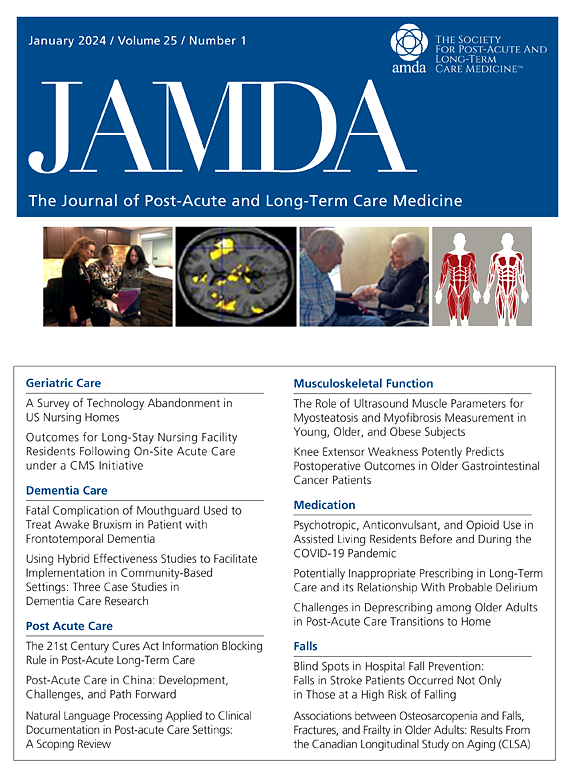Diagnostic Prediction Models for Sarcopenia: A Systematic Review and Meta-Analysis
IF 4.2
2区 医学
Q2 GERIATRICS & GERONTOLOGY
Journal of the American Medical Directors Association
Pub Date : 2025-06-16
DOI:10.1016/j.jamda.2025.105698
引用次数: 0
Abstract
Objectives
Early detection and diagnosis of sarcopenia remain challenging. Despite significant progress in predictive modeling, there is no comprehensive evaluation of their diagnostic performance and methodologic quality across different modeling approaches and populations. This study aims to systematically evaluate the diagnostic accuracy of prediction models for sarcopenia across different modeling approaches and reference standards.
Design
Systematic review and meta-analysis of diagnostic test accuracy studies.
Setting and Participants
Both men and women at any age and ethnicity with sarcopenia, regardless of comorbidities.
Methods
We systematically searched Ovid MEDLINE, Embase, and Cochrane Central databases until June 2024. Studies developing or validating prediction models for sarcopenia diagnosis were included. We performed a bivariate random-effects meta-analysis and used hierarchical summary receiver operating characteristic models to synthesize diagnostic accuracy data.
Results
Thirteen studies comprising 122,252 participants were included. The prediction models demonstrated robust overall performance in development sets [sensitivity, 82%; 95% CI, 75%-87%; specificity, 84%; 95% CI, 74%-90%; area under curve (AUC), 0.89; 95% CI, 0.86-0.91) and internal validation sets (AUC, 0.86; 95% CI, 0.83-0.89]. In validation sets, traditional statistical models maintained consistent performance (sensitivity, 86%; 95% CI, 80%-91%; specificity, 72%; 95% CI, 67%-77%), whereas machine learning approaches achieved higher specificity (84%; 95% CI, 71%-91%) despite moderate sensitivity (70%; 95% CI, 56%-81%). Only one study conducted external validation, reporting moderate sensitivity (71%; 95% CI, 62%-78%) and excellent specificity (98%; 95% CI, 96%-99%) with an AUC of 0.97.
Conclusions and Implications
Current prediction models show promising diagnostic accuracy for sarcopenia, with different modeling approaches having complementary strengths. However, further research is needed to address the limitations of existing models, including methodologic heterogeneity and limited external validation, before clinical implementation can be recommended.
肌少症的诊断预测模型:系统回顾和荟萃分析。
目的:早期发现和诊断肌肉减少症仍然具有挑战性。尽管在预测建模方面取得了重大进展,但在不同的建模方法和人群中,还没有对其诊断性能和方法质量进行全面评估。本研究旨在系统评估不同建模方法和参考标准下肌少症预测模型的诊断准确性。设计:对诊断测试准确性研究进行系统回顾和荟萃分析。环境和参与者:患有肌肉减少症的任何年龄和种族的男性和女性,不论是否合并症。方法:系统检索Ovid MEDLINE、Embase和Cochrane Central数据库至2024年6月。研究开发或验证预测模型的肌肉减少症诊断包括在内。我们进行了双变量随机效应荟萃分析,并使用分层汇总接收者操作特征模型来综合诊断准确性数据。结果:13项研究包括122,252名参与者。预测模型在开发集中表现出稳健的总体性能(敏感性,82%;95% ci, 75%-87%;特异性,84%;95% ci, 74%-90%;曲线下面积[AUC], 0.89;95% CI, 0.86-0.91)和内部验证集(AUC, 0.86;95% ci, 0.83-0.89)。在验证集中,传统统计模型保持一致的性能(灵敏度,86%;95% ci, 80%-91%;特异性,72%;95% CI, 67%-77%),而机器学习方法具有更高的特异性(84%;95% CI, 71%-91%),尽管中度敏感性(70%;95% ci, 56%-81%)。只有一项研究进行了外部验证,报告了中度敏感性(71%;95% CI, 62%-78%)和极好的特异性(98%;95% CI, 96%-99%), AUC为0.97。结论和意义:目前的预测模型显示出对肌肉减少症的诊断准确性,不同的建模方法具有互补的优势。然而,在推荐临床应用之前,需要进一步的研究来解决现有模型的局限性,包括方法学的异质性和有限的外部验证。
本文章由计算机程序翻译,如有差异,请以英文原文为准。
求助全文
约1分钟内获得全文
求助全文
来源期刊
CiteScore
11.10
自引率
6.60%
发文量
472
审稿时长
44 days
期刊介绍:
JAMDA, the official journal of AMDA - The Society for Post-Acute and Long-Term Care Medicine, is a leading peer-reviewed publication that offers practical information and research geared towards healthcare professionals in the post-acute and long-term care fields. It is also a valuable resource for policy-makers, organizational leaders, educators, and advocates.
The journal provides essential information for various healthcare professionals such as medical directors, attending physicians, nurses, consultant pharmacists, geriatric psychiatrists, nurse practitioners, physician assistants, physical and occupational therapists, social workers, and others involved in providing, overseeing, and promoting quality

 求助内容:
求助内容: 应助结果提醒方式:
应助结果提醒方式:


